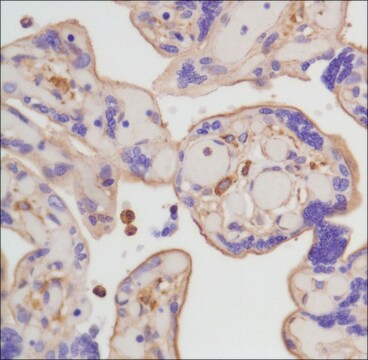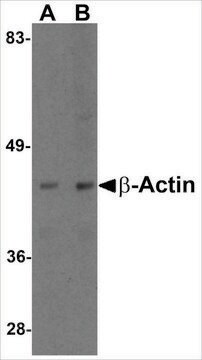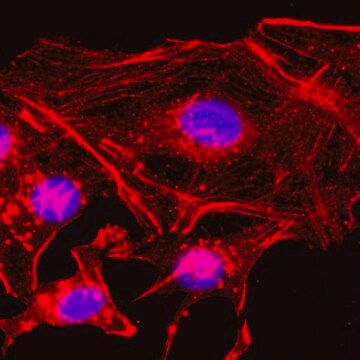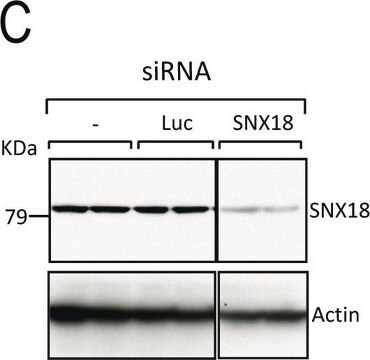ABT264
Anti-beta Actin Antibody, arginylated (N-terminal)
from rabbit, purified by affinity chromatography
Synonym(e):
Actin, cytoplasmic 1, arginylated, beta Actin, arginylated
About This Item
Empfohlene Produkte
Biologische Quelle
rabbit
Qualitätsniveau
Antikörperform
affinity isolated antibody
Antikörper-Produkttyp
primary antibodies
Klon
polyclonal
Aufgereinigt durch
affinity chromatography
Speziesreaktivität
mouse, rat, human
Speziesreaktivität (Voraussage durch Homologie)
orangutan (based on 100% sequence homology), canine (based on 100% sequence homology), rabbit (based on 100% sequence homology), hamster (based on 100% sequence homology)
Methode(n)
dot blot: suitable
immunocytochemistry: suitable
western blot: suitable
NCBI-Hinterlegungsnummer
UniProt-Hinterlegungsnummer
Versandbedingung
wet ice
Posttranslationale Modifikation Target
unmodified
Angaben zum Gen
human ... ACTB(60)
Allgemeine Beschreibung
Spezifität
Immunogen
Anwendung
Zellstruktur
Cytoskelett
Western Blotting Analysis: 2.0 µg/mL from a representative lot detected N-terminally arginylated beta actin in human (HeLa, HEK293, HepG2, HUVEC, Jurkat, PC3), rat (PC-12 pheochromocytoma), and murine (C2C12 myoblast, NIH/3T3, and Raw 264.7) cell lysates, as well as in human placenta and mouse brain tissue homogenates.
Dot Blot Analysis: 0.2 µg/mL from a representative lot detected immunogen peptide, but not the corresponding peptide without the N-terminus arginine (Courtesy of Dr. Anna Kashina, University of Pennsylvania, Philadelphia, PA).
Western Blotting Analysis: 0.2 µg/mL from a representative lot detected greatly reduced beta actin N-terminal arginylation modification in Arg-transfer RNA (Arg-tRNA) protein transferase (Ate1) knockout mouse embryonic fibroblasts (Courtesy of Dr. Anna Kashina, University of Pennsylvania, Philadelphia, PA).
Note: Goat serum is found to interfere with the staining by this polyclonal antibody, BSA is recommended for sample blocking when using this product.
Qualität
Western Blotting Analysis: 2.0 µg/mL of this antibody detected N-terminally arginylated beta actin in human A431 cell lysate.
Zielbeschreibung
Physikalische Form
Lagerung und Haltbarkeit
Sonstige Hinweise
Haftungsausschluss
Sie haben nicht das passende Produkt gefunden?
Probieren Sie unser Produkt-Auswahlhilfe. aus.
Empfehlung
Lagerklassenschlüssel
12 - Non Combustible Liquids
WGK
WGK 1
Flammpunkt (°F)
Not applicable
Flammpunkt (°C)
Not applicable
Analysenzertifikate (COA)
Suchen Sie nach Analysenzertifikate (COA), indem Sie die Lot-/Chargennummer des Produkts eingeben. Lot- und Chargennummern sind auf dem Produktetikett hinter den Wörtern ‘Lot’ oder ‘Batch’ (Lot oder Charge) zu finden.
Besitzen Sie dieses Produkt bereits?
In der Dokumentenbibliothek finden Sie die Dokumentation zu den Produkten, die Sie kürzlich erworben haben.
Kunden haben sich ebenfalls angesehen
Unser Team von Wissenschaftlern verfügt über Erfahrung in allen Forschungsbereichen einschließlich Life Science, Materialwissenschaften, chemischer Synthese, Chromatographie, Analytik und vielen mehr..
Setzen Sie sich mit dem technischen Dienst in Verbindung.









